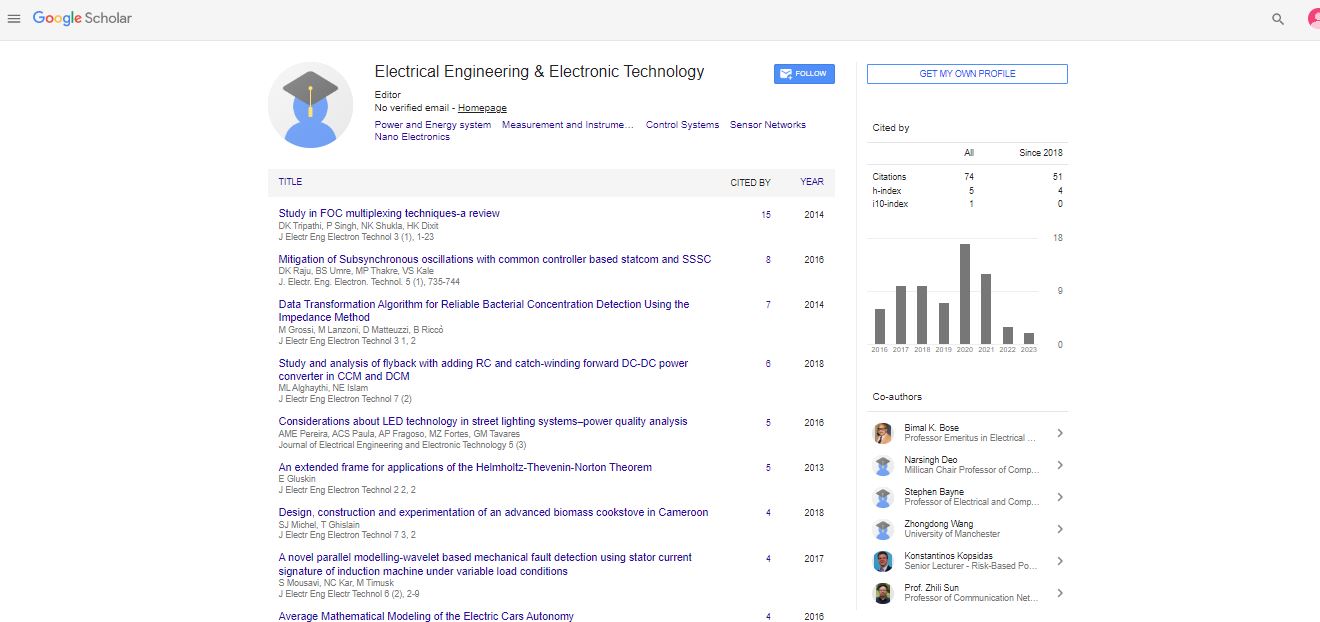Editorial, J Electr Eng Electron Technol Vol: 14 Issue: 1
Signal Amplification: Enhancing the Power of Electrical Signals
Petere Grace*
Department of Microelectronics, University of Melbourne, University of Melbourne, Australia
- *Corresponding Author:
- Petere Grace
Department of Microelectronics, University of Melbourne, University of Melbourne, Australia
E-mail: petere856@gmail.com
Received: 01-Jan-2025, Manuscript No. jeeet-25-170003; Editor assigned: 4-Jan-2025, Pre-QC No. jeeet-25-170003 (PQ); Reviewed: 18-Jan-2025, QC No. jeeet-25-170003; Revised: 25-Jan-2025, Manuscript No. jeeet-25-170003 (R); Published: 30-Jan-2025, DOI: 10.4172/2325-9838.1000989
Citation: Petere G (2025) Signal Amplification: Enhancing the Power of Electrical Signals. J Electr Eng Electron Technol 14: 989
Introduction
Signal amplification is a fundamental concept in electrical and electronic engineering. It refers to the process of increasing the strength, or amplitude, of an electrical signal without altering its essential characteristics. This process is crucial in various applications, including audio systems, communication devices, medical equipment, and instrumentation. Whether boosting a microphone input in a concert hall or strengthening a weak signal from a sensor in an industrial machine, amplification ensures the signal is strong enough for further processing or interpretation.
Discussion
Signal amplification is achieved using electronic amplifiers, which are circuits designed to receive a weak input signal and produce a stronger output signal. The key component of most amplifiers is a transistor or an operational amplifier (op-amp). These devices can control large amounts of current or voltage based on a small input, making them ideal for amplification purposes.
There are several types of signal amplifiers, including:
- Voltage amplifiers: Increase the voltage of the signal.
- Current amplifiers: Boost the current level of a signal.
- Power amplifiers: Increase both current and voltage to enhance overall power.
Each amplifier type serves different roles depending on the requirements of the system. For example, in audio systems, voltage amplifiers increase the signal from a microphone so it can drive speakers effectively. In medical devices like ECG machines, amplifiers are used to boost tiny electrical signals from the human body so they can be analyzed.
One of the important considerations in signal amplification is linearity. An ideal amplifier should faithfully increase the signal amplitude without distorting its shape. Non-linear amplification can introduce distortion, which degrades the quality of the signal. Therefore, maintaining a linear response is critical in high-fidelity audio systems and sensitive measuring instruments.
Another important aspect is gain, which defines how much the signal is amplified. Gain is usually expressed in decibels (dB). For instance, a gain of 20 dB means the signal is amplified 10 times in voltage.
However, signal amplification also comes with challenges. One of the most common issues is noise amplification. Since amplifiers increase all signal components—including noise—it is crucial to design systems with a high signal-to-noise ratio (SNR). Proper grounding, shielding, and using low-noise amplifier components help mitigate this problem.
In modern electronics, amplification is often integrated into microchips, enabling compact and efficient signal processing in devices such as smartphones, hearing aids, and communication systems.
Conclusion
Signal amplification is a core technology that enables modern electronics to function effectively. By increasing the strength of electrical signals, amplifiers allow devices to transmit, receive, and interpret information more accurately and efficiently. Whether in entertainment, healthcare, telecommunications, or industrial automation, amplification remains essential for enhancing performance and ensuring reliability. As technology advances, the demand for high-quality, low-noise, and energy-efficient amplifiers will continue to grow, driving innovation in both analog and digital signal processing.
References
- Albert Mathieu, Hodges Brian, Regehr Glenn (2007). Research in Medical Education: Balancing Service and Science. Adv Health Sci Educ. 12103-15.
- Anspach Renee R (1988). Notes on the Sociology of Medical Discourse: The Language of Case Presentation. J Health Soc Behav. 29: 357-75.
- Bassett Andrew Mark, Brosnan Caragh, Southgate Erica, Lempp Heidi (2018). Transitional Journeys into, and through Medical Education for First-in-Family (FiF) Students: A Qualitative Interview Study. BMC Medical Education. 18: 102.
- Beagan Brenda L (2000). Neutralizing Differences: Producing Neutral Doctors for (Almost) Neutral Patients. Soc Sci Med. 51: 1253-65.
- Beagan Brenda (2003). Teaching Social and Cultural Awareness to Medical Students: â??Itâ??s All Very Nice to Talk about It in Theory, but Ultimately It Makes No Difference. Academic Medicine. 78: 605-14.
Indexed at, Google scholar, Cross ref
Indexed at, Google scholar, Cross ref
Indexed at, Google scholar, Cross ref
Indexed at, Google scholar, Cross ref
 Spanish
Spanish  Chinese
Chinese  Russian
Russian  German
German  French
French  Japanese
Japanese  Portuguese
Portuguese  Hindi
Hindi 
